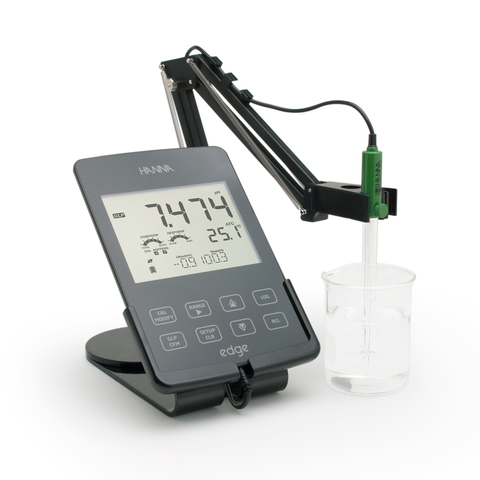
The edge pH meter from Hanna Instruments, distributed in the UK by Wolflabs, is an innovative piece of equipment for the laboratory measurement of pH, conductivity and dissolved oxygen.
The edge weighs in at just 250 grams, with a thickness of only 12.7mm and can be wall-mounted to make it even less obtrusive.
The screen is remarkably easy to read with a display viewable from over 5 meters and a wide 150° viewing angle. The edge comes with advanced digital electrodes that match the sophistication of the edge itself.
Electrodes have an easy to plug in 3.5 mm connector to prevent pin and angle alignment problems. Each has a built-in microchip for storing sensor type, ID and calibration information, which is automatically retrieved by the instrument when the electrode is plugged in.
Conductivity calibration information includes time and date, calibrated conductivity standards, stored pH, calibrated buffers, offset and sensor cell constant. Dissolved oxygen calibration information includes: time and date, standards used for calibration, altitude and salinity correction.
The edge allows you to store up to 1000 log records of data and is designed to simplify measurement, configuration, calibration, diagnostics and logging and transferring data to a computer or an USB drive.
It also features Hanna’s exclusive CAL-CHECK®. This is designed to warn you if the electrode in use is not clean or if buffers are contaminated. Additionally the edge will let you know if the pH bulb is cracked and if the junction of the electrode is in any way compromised.
The edge includes one standard USB for exporting data with a flash drive and one micro USB port for operators to connect to a computer for file export and for charging the instrument if the cradle is not available. The cradle itself has an adjustable swivel electrode holder to charge and hold the edge securely in place at the optimum angle.
The edge represents the implementation of Hanna’s knowledge and understanding of what a pH, conductivity and dissolved oxygen meter needs to achieve in the laboratory of today.
For more information about the edge, please click here.




